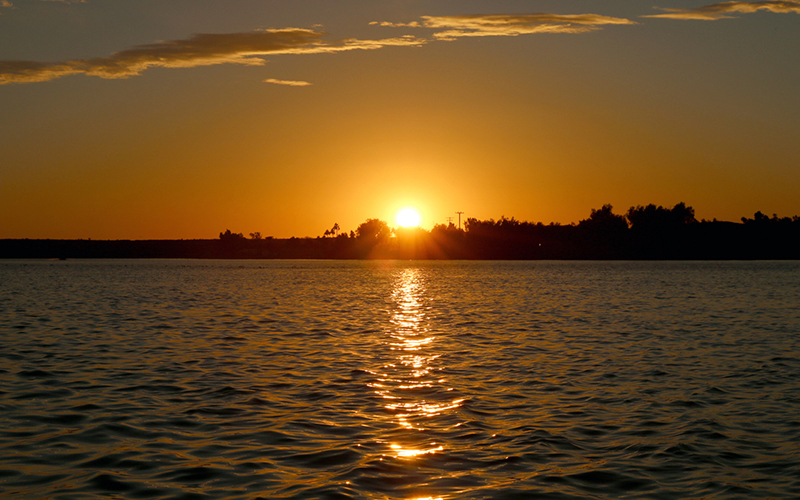
This spring, representatives of Upper Basin states criticized Arizona’s lack of progress, as well as a CAP strategy to maximize water discharges from Lake Powell downriver to Lake Mead, which supplies Arizona. (File photo by Joshua Bowling/Cronkite News)
PHOENIX – Water managers in Arizona again are trying to strike a deal that would help prepare the state for future cuts to its water supply if Lake Mead drops below specific levels, which could come as early as 2020.
The renewed effort to forge the Drought Contingency Plan comes after a year of anxiety and gridlock over the future of the Colorado River in a time of higher temperatures and dwindling precipitation. More than 40 million people rely on the river for water.
And as Arizona tries again, the six other states in the vast Colorado River Basin – Colorado, Utah, Nevada, California, Wyoming and New Mexico – are watching intently.
In 2017, the United States and Mexico agreed to a new strategy that would lead to increased savings of water by Mexico, but that agreement will only go into effect if Arizona, California and Nevada finalize internal agreements that will allow its agencies to join the drought plan for the Lower Basin.
A brief recap: Arizona Gov. Doug Ducey held a series of water meetings last year that ended in a stalemate between the Arizona Department of Water Resources and the Central Arizona Project, which pumps Colorado River water to Phoenix and Tucson.
This spring, representatives of Upper Basin states criticized Arizona’s lack of progress, as well as a CAP strategy to maximize water discharges from Lake Powell downriver to Lake Mead, which supplies Arizona.
The Legislature adjourned in early May without producing meaningful new water laws. Progress on Arizona’s drought plan had stalled.
Time to reboot
In a joint interview, Tom Buschatzke, director the Arizona Department of Water Resources, and Ted Cooke, general manager of the Central Arizona Water Conservation District, which runs the CAP, said they have been discussing their differences for the past several weeks.
Federal officials will visit Tempe next week for a briefing on the state of the Colorado. U.S. Reclamation Commissioner Brenda Burman, who in late May urged the Lower Basin states to finish their drought-contingency plan, will be among the speakers.
“On the one hand, I don’t want to say that the only reason that Tom and I are (embarking on) this initiative is because we’ve been pressured to do so by folks,” Cooke said of the renewed effort to finish the plan.
“On the other hand, I don’t want to say it’s a complete coincidence of timing.”
Buschatzke said having Burman kick off a public process will remind people that Arizona has been better off when it avoided lawsuits.
“When the state has moved with the federal government into that paradigm, away from, ‘Let’s have a bunch of big fights and litigation,’ we better control our own destiny,” he said.
Eyes on Arizona
Fights and litigation would only delay a coordinated response to rising temperatures and falling water levels in Lakes Mead and Powell, the largest reservoirs on the Colorado.
“The situation in Arizona is a topic of a lot of discussion in the Upper Basin,” said Jim Lochhead, CEO of Denver Water, adding that Arizona’s internal conflict has led to political problems in Colorado.
“It puts pressure on Denver Water as a municipal utility, taking water out of the Colorado River,” he said, “and it exacerbates historic animosities and relationships between western Colorado and Denver Water.”
Lochhead sent a letter to the CAP in April threatening to pull out of a program to conserve water unless the Lower Basin made real progress on its drought plan.
Water shortages are so likely, California has agreed to take reductions – something not required under current rules.
Pat Mulroy, a longtime water leader in Nevada who’s now at the University of Nevada Las Vegas, said there is no time to waste.
“You have to ask yourself, given the position that you’re in, why would you let that opportunity go by?” she asked.
Arizona issues
But before it can sign a Lower Basin plan, Arizona needs its own deal. One difficult subject is what to do about farmers in central Arizona, who would take a big hit under the current rules if the surface of Lake Mead falls below 1,075 feet above sea level. At that point, water deliveries to Arizona would be cut 11 percent.
“How do we find a way to make things less painful for them?” Cooke asked. “Not completely painless, but less painful.”
Another big issue is determining who gets to decide what water stays in Lake Mead. It’s a major question that Buschatzke said was still “under discussion.”
“We will work that out,” Cooke added. To get to “yes,” he and Buschatzke agreed, they’ll have to avoid letting side issues divert the talks.
Buschatzke said his task is “to find a collective way to create a package where everyone is better off with the package, even though there might be individual pieces of that package that they might not particularly like 100 percent.”
This story is part of Elemental: Covering Sustainability, a new multimedia collaboration between Cronkite News, Arizona PBS, KJZZ, KPCC, Rocky Mountain PBS and PBS SoCal.
Subscribe to the Cronkite News podcast In Focus on iTunes.